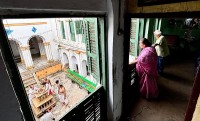NIL
RBI keeps key rates unchanged, may cut early Jan
Mumbai, Dec 2 (IBNS) The Reserve Bank of India (RBI) on Tuesday kept the policy repo rate under the liquidity adjustment facility (LAF) unchanged at 8.0 per cent, but said if the current inflation momentum and changes in inflationary expectations continue, and fiscal developments are encouraging, a change in the monetary policy stance is likely early next year, including outside the policy review cycle..
In its fifth Bi-Monthly Monetary Policy Statement, RBI Governor Raghuram G Rajan said on the basis of an assessment of the current and evolving macroeconomic situation, it has been decided to keep the policy repo rate under the liquidity adjustment facility (LAF) unchanged at 8.0 per cent;
He announced to keep the cash reserve ratio (CRR) of scheduled banks unchanged at 4.0 per cent of net demand and time liabilities (NDTL);
RBI policy will continue to provide liquidity under overnight repos at 0.25 per cent of bank-wise NDTL at the LAF repo rate and liquidity under 7-day and 14-day term repos of up to 0.75 per cent of NDTL of the banking system through auctions; and
Daily one-day term repos and reverse repos to smooth liquidity would be continued.
Consequently, the reverse repo rate under the LAF will remain unchanged at 7.0 per cent, and the marginal standing facility (MSF) rate and the Bank Rate at 9.0 per cent, RBI said.
Since the fourth bi-monthly monetary policy statement of September 2014, the global economy has slowed, though the recent sharp fall in crude prices will have a net positive impact on global growth. The recovery in the United States is broadening on the back of stronger domestic consumption, rising investment and industrial activity. In the Euro area, headwinds from recessionary forces continue to weaken industrial production and investment sentiment. In Japan, growth may be picking up again on the back of stronger exports, helped in part by further quantitative and qualitative easing that has led to a depreciation of the yen. In China, disappointing activity and still-low inflation have prompted rate cuts by the People’s Bank of China. In other major emerging market economies (EMEs), downside risks to growth from elevated inflation, low commodity prices, deteriorating labour market conditions and stalling domestic demand have become accentuated.
Notwithstanding the cessation of asset purchases by the US Fed, financial markets have remained generally buoyant on abundant liquidity stemming from accommodative monetary policies in the advanced economies (AEs). The search for yield has driven global equity markets to new highs, with investors shunning gold and commodities. Capital flows to EMEs recovered from market turbulence in the first half of October, although some discrimination on the basis of fundamentals is becoming discernible.
According to RBI, domestic activity weakened in Q2 of 2014-15, and activity is likely to be muted in Q3 also because of a moderate kharif harvest. The deficiency in the north-east monsoon rainfall has constrained the pace of rabi sowing, except in the southern States.
Despite reasonable levels of water storage in major reservoirs, the rabi crop is unlikely to compensate for the decline in kharif production earlier in the year and consequently, agricultural growth in 2014-15 is likely to be muted. This, along with a slowdown in rural wage growth, is weighing on rural consumption demand.
Despite the uptick in September, the growth of industrial production slumped to 1.1 per cent in Q2 with negative momentum in September, unable to sustain the improvement recorded in the preceding quarter. The persisting contraction in the production of both capital goods and consumer goods in Q2 reflected weak aggregate domestic demand.
However, more recent readings of core sector activity, automobile sales and purchasing managers’ indices suggest improvement in likely activity. Exports have buffered the slowdown in industrial activity in Q2 but, going forward, require support from partner country growth.
In the services sector, the October’s purchasing managers’ survey indicates deceleration in new business. In contrast, tourist arrivals and domestic and international cargo movements have shown improvement. Thus, various constituents of the services sector are emitting mixed signals.
A rise in investment is critical for a sustained pick-up in overall economic activity. While low capacity utilisation in some sectors is a dampener, the recent strong improvement in business confidence and in investment intentions should help. In this context, the still slow pace of reviving stalled projects, despite government efforts, warrants policy priority, even as ongoing efforts to ease stress in the financial system unlock resources for financing the envisaged investment push.
RBI said the fiscal outlook should brighten because of the fall in crude prices, but weak tax revenue growth and the slow pace of disinvestment suggest some uncertainty about the likely achievement of fiscal targets, and the quality of eventual fiscal adjustment. The government, however, appears determined to stay on course.
Retail inflation, as measured by the consumer price index (CPI), has decelerated sharply since the fourth bi-monthly statement of September. This reflects, to some extent, transitory factors such as favourable base effects and the usual softening of fruits and vegetable prices that occurs at this time of the year. On the other hand, protein-rich items such as milk and pulses continue to experience upside pressures, reflecting structural mismatches in supply and demand. The absence of adequate administered price revisions in inputs like electricity has contributed to the easing of inflation in the fuel group.
In the non-food non-fuel category, inflation eased broadly in September. Further softening of international crude prices in October eased price pressures in transport and communication. However, upside pressures persist in respect of prices of clothing and bedding, housing and other miscellaneous services, resulting in non-food non-fuel inflation for October remaining flat at its level in the previous month, and above headline inflation.
Survey-based inflationary expectations have been coming down with the fall in prices of commonly-bought items such as vegetables, but are still in the low double digits. Administered price corrections, as and when they are effected, weaker-than-anticipated agricultural production, and a possible rise in energy prices on the back of geo-political risks could alter the currently benign inflation outlook significantly.
Liquidity conditions have eased considerably in Q3 of 2014-15 due to structural and frictional factors, as well as the fine tuning of the liquidity adjustment framework. With deposit mobilisation outpacing credit growth and currency demand remaining subdued in relation to past trends, banks are flush with funds, leading a number of banks to reduce deposit rates.
The Reserve Bank determines the need for open market operations (OMO) based on its assessment of monetary conditions rather than on a specific view on long term yields. On an assessment of the permanent liquidity conditions, the Reserve Bank conducted OMO sales worth `401 billion during October to December so far.
Merchandise exports declined in October, mainly reflecting sluggish external demand conditions, but also the softening of international prices resulting in lower realisations. For the period April-October as a whole, however, export growth remained positive although the deceleration since July requires vigilance. With import growth remaining modest on account of the decline in POL imports due to falling crude prices, the trade deficit narrowed from its level a year ago.
Gold imports have surged since September in volume terms, largely reflecting seasonal demand. Barring month-to-month variations, non-oil non-gold import growth has remained moderate, with anecdotal evidence of imports substituting for shortfalls in domestic production. Even as external financing requirements stay moderate, all categories of capital flows, except non-resident deposits, have been buoyant. The consequent accretion to reserves denominated in US dollars has been moderated by valuation effects resulting from the strength of the US dollar.
On the outlook for inflation in the medium-term, RBI said projections at this stage will be contingent upon expectations of a normal south-west monsoon in 2015, international crude prices broadly around current levels and no change in administered prices in the fuel group, barring electricity. Over the next 12-month period, inflation is expected to retain some momentum and hover around 6 per cent, except for seasonal movements, as the disinflation momentum works through. Accordingly, the risks to the January 2016 target of 6 per cent appear evenly balanced under the current policy stance.
RBI said some easing of monetary conditions has already taken place. The weighted average call rates as well as long term yields for government and high-quality corporate issuances have moderated substantially since end-August. However, these interest rate impulses have yet to be transmitted by banks into lower lending rates. Indeed, slow bank credit growth is mirrored by increasing reliance of large corporations on commercial paper and domestic as well as external public issuances.
Top Headlines
-
News
CSR in the Crossfire: Professor and practitioners debate over ethics in India Inc. at Kolkata's MCHD talk
October 24, 2025
-
News
Jashanpreet Singh Case: California under fire for licensing undocumented truck driver
October 24, 2025
-
News
India upgrades Technical Mission in Kabul to Embassy, days after Muttaqi's visit to New Delhi
October 22, 2025
-
News
Pakistan, Afghanistan agree to 48-hour ceasefire after deadly border clashes
October 15, 2025
-
News
Afghan Taliban, Pakistan exchange gunfire, dozens killed
October 15, 2025
-
News
Trump hails Netanyahu in Israel after hostage release, declares historic dawn of a new Middle East
October 13, 2025
-
News
Historic dawn of a new Middle East: Donald Trump addresses Israeli Parliament
October 13, 2025
-
News
Shah Rukh Khan receives maiden National Award from President Droupadi Murmu
September 23, 2025
-
News
Kolkata: Ahiritola Yubak Brinda invites Auram to make jewellery for Ma Durga and her family
September 20, 2025
-
News
Israel-US alliance 'never been stronger', Netanyahu says as State Secretary Rubio visit for talks
September 15, 2025





